
Santa Ana de los Cuatro Ríos de Cuenca, commonly referred to as Cuenca, is the capital and largest city of the Azuay Province of Ecuador. Cuenca is located in the highlands of Ecuador at about 2,560 metres above sea level, with an urban population of approximately 329,928 and 661,685 inhabitants in the larger metropolitan area.

A décima is a ten-line stanza of poetry. The most popular form is called décima espinela after Vicente Espinel (1550–1624), a Spanish writer, poet, and musician from the Siglo de Oro who used it extensively throughout his compositions.

The Quito School is a Latin American artistic tradition that constitutes essentially the whole of the professional artistic output developed in the territory of the Royal Audience of Quito – from Pasto and Popayán in the north to Piura and Cajamarca in the south – during the Spanish colonial period (1542–1824). It is especially associated with the 17th and 18th centuries and was almost exclusively focused on the religious art of the Catholic Church in the country. Characterized by a mastery of the realistic and by the degree to which indigenous beliefs and artistic traditions are evident, these productions were among of the most important activities in the economy of the Royal Audience of Quito. Such was the prestige of the movement even in Europe that it was said that King Carlos III of Spain (1716–1788), referring to one of its sculptors in particular, opined: "I am not concerned that Italy has Michelangelo; in my colonies of America I have the master Caspicara".
Eduardo Estrella Aguirre was an Ecuadorian doctor and researcher who published Flora Huayaquilensis: The Botanical Expedition of Juan Tafalla 1799-1808.
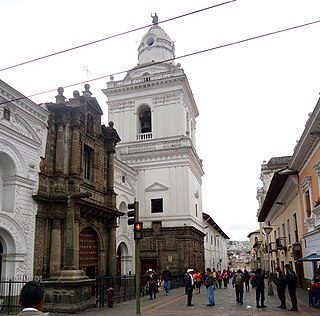
The Church and convent of San Agustín is a Catholic temple located in the Historic Center of the city of Quito, run by the Augustinian Order. The complex of the temple and convent is located on calle Chile, between Guayaquil and Flores.
In almost three centuries of the Spanish Colonization Period, close to one thousand cities were founded in the Americas. These new towns were built in accordance to several legislative documents that were given by the Spanish Crown to regulate, among many other aspects in the American Colonies, the creation of new settlements. In order to assure a long lasting presence of the Spanish Crown, the command given to the Conquistadors was that the settlements were to be permanent so they could have a strategic role in the discovery, conquest and administration of the new world.

La Iglesia de El Sagrario is a Renaissance Catholic church in the city of Quito, capital of Ecuador. It is located in the Historic Center of the city, on calle García Moreno, formerly known as calle de las Siete Cruces, a few meters from the corner with calle Eugenio Espejo. It is part of the Metropolitan Cathedral complex, although it seems more like an independent church than an adjoining chapel, both because of its size and because of its importance in Quito's art.

The Basilica of Nuestra Señora de la Merced, is a Catholic temple located in the Historic Center of the city of Quito, capital of Ecuador. It is the first church and headquarters of the Mercedarian Order in the country, and for this reason it bears the title of Basilica.

The Ara Christi Charterhouse, or the Cartuja de Ara Christi, is a former Carthusian monastery located just outside the town of El Puig in the province of Valencia, Spain. The site now includes a hotel and utilizes the facilities for functions.

Excursion in the Countryside of Infanta Isabel Clara Eugenia is an oil on canvas painting by Flemish artists Jan Brueghel the Elder and Joos de Momper. It was painted in the first quarter of the 17th century, and is housed at the Museum of Prado, in Madrid.
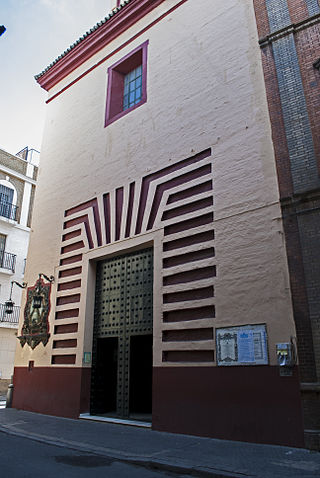
St. Buenaventura's Church is situated in the calle Carlos Cañal in the Casco Antiguo of Seville, Andalusia, Spain. It was the church of the Franciscan College of San Buenaventura that was destroyed in the 19th century.
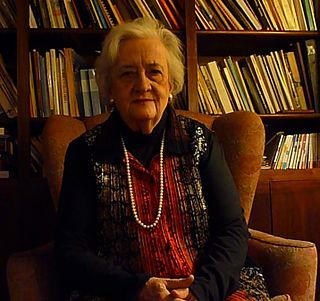
Noemí Goytia is an Argentine architect and professor specialized in history, criticism, heritage and project processes. She has received the CICOP Lifetime Achievement Award from the International Center for Heritage Conservation in 2014. She is the author of numerous books and magazine articles on her specialty.
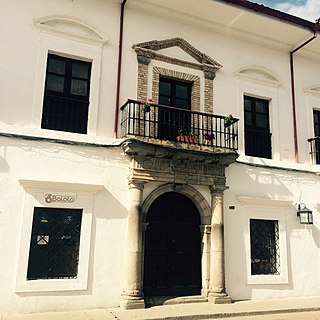
The Popayán Archdiocesan Museum of Religious Art is a museum located in the capital of the department of Cauca, Colombia. The museum is mainly dedicated to exhibit sacred art.

The Church of Santo Domingo is a Catholic church in the historic center of the city of Quito, capital of Ecuador. The complex of convent, church and chapels is located on the Plaza de Santo Domingo, itself named after the church.
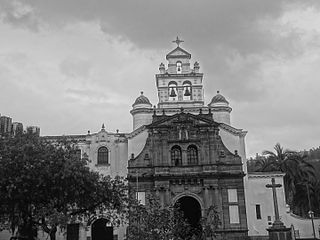
The Church and Monastery of Our Lady of Guápulo was the first Marian shrine in what is now the Republic of Ecuador, founded in 1620 in Guápulo, a beautiful corner located northeast of the city of Quito, the capital of the country, located at 2,690 meters above sea level. Friar Juan de Dios Navas affirmed that this Shrine is one of the best relics inherited from the Colony. The image of the Virgin of Guápulo was the model used for the sculpture of Our Lady of El Cisne and also that of El Quinche.

The Church and monastery of El Carmen Alto is a Catholic complex of convent, church and chapels built in the historic center of the city of Quito, capital of Ecuador, on calle García Moreno, formerly known as De las Siete Cruces, on the corner of Rocafuerte.














































